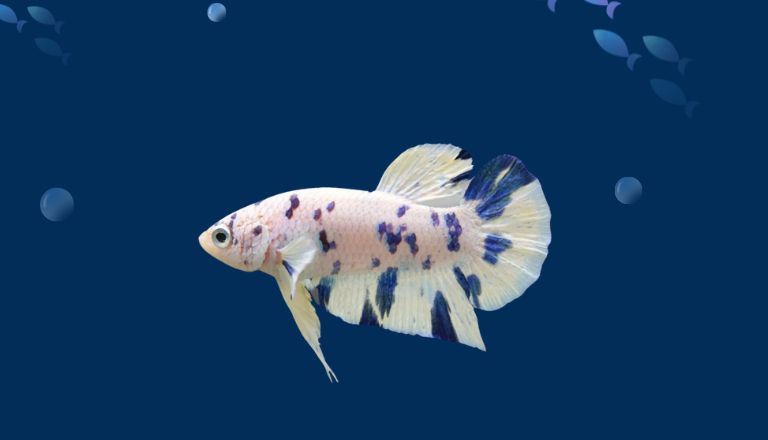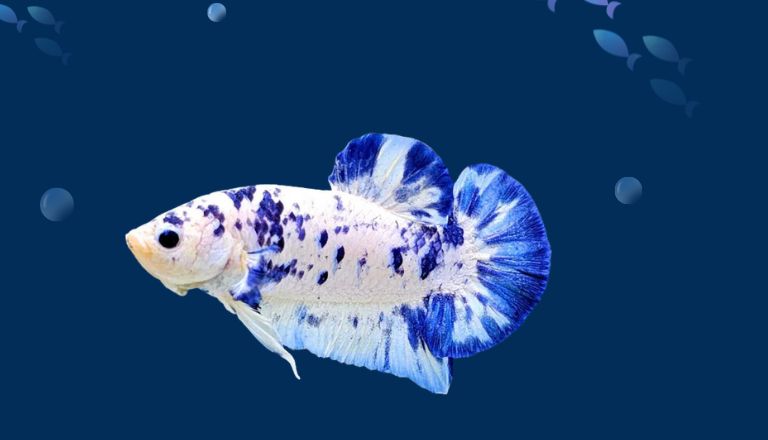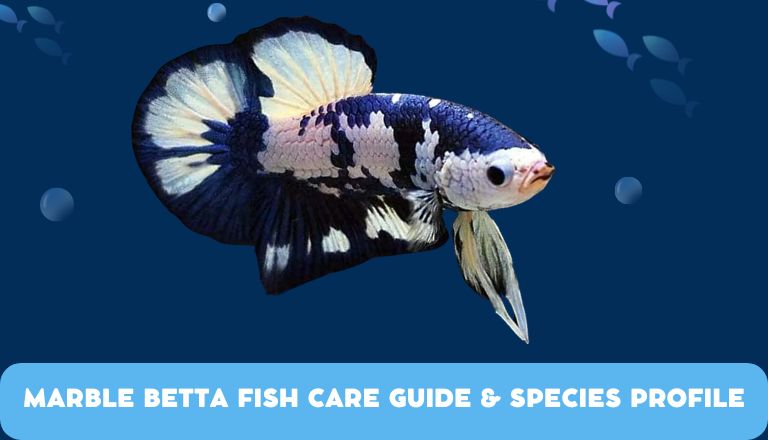Marble Betta Fish Care Guide & Species Profile
Marble Betta fish are captivating creatures with swirling patterns and vibrant colors. This guide covers tank setup, water quality, feeding, and health issues and explores how to care for Marble Betta fish and help them thrive in your aquarium. Join us for the incredible journey.
Marble Betta Fish Facts & Overview
Koi Betta fish are a stunning addition to any aquarium. These fish have a moderate care level. They require a stable tank environment with proper filtration and regular water changes. Koi Bettas can be housed with peaceful tank mates.

They have beautiful colors with red, white, and metallic shades. With proper care and a balanced diet, they can live up to 3-5 years in captivity. Provide them with at least 5 gallons of water per fish in an aquarium.
Origin
The Marble Betta Fish has a unique origin story. Selective breeding among Siamese fighting fish created their stunning color patterns. The Marble gene produces endless color combinations, making each fish one-of-a-kind.
These fish trace back to wild Betta Splendens in Southeast Asia, known for their beauty. Breeders have improved the Marbling trait over time. Now, Marble Bettas come in diverse patterns and colors that attract hobbyists.
The breeders’ creativity has turned these fish into works of art, enchanting us with their vibrant colors and designs in aquariums.
Marble Betta Size & Lifespan
These beautiful fish have eye-catching patterns that stand out in aquariums. They are small, growing to 2-3 inches, so they are great for smaller tanks.
With proper care, they live for 4-5 years. They change color and pattern, which adds surprise to their beauty. If you want colorful and unique fish for your aquarium, choose a Marble Betta.
Appearance
These fish are known for their stunning appearance. They have a unique color pattern that looks like swirling marble, which is why they are called Marble Bettas. Each fish has a different mix of colors and patterns, making them popular among fish lovers.

They change colors over time. This ability makes each betta a constantly changing piece of art that keeps owners fascinated. They show off bright blues, fiery reds, or shiny green colors. Marble Bettas always leave a strong impression on anyone who sees them.
Behavior
They have fascinating behavior in aquariums. They have unique and changing colors that react to different things like stress or mood. These fish are territorial and will defend their space in the tank.
They show aggression and dominance. These fish are also curious and intelligent, exploring their surroundings and interacting with objects. Their mix of territorial instincts, color changes, and curiosity make them interesting to watch and study.
Habitat and Tank Requirements
Marble Betta fish, also called fancy Betta fish, need specific tank conditions to be healthy. When setting up a tank, give them places to hide and plants for comfort. Keep the water temperature stable for their health.
Make the tank look like their natural habitat to feel comfortable and show their true colors and behaviors. By meeting their tank needs, you can enjoy watching these beautiful fish thrive.
Tank Conditions
Maintain optimal tank conditions for their health and happiness. These vibrant and colorful fish thrive in a well-maintained aquarium with a temperature range of 78-80°F and a pH level between 6.5 and 7.5. Give them lots of places to hide and live plants to make them feel safe and comfortable like they would in the wild.
Regularly changing the water in the tank is important to keep Marble Bettas healthy because they are sensitive to toxins. Use a high-quality filtration system to keep the water clean and oxygenated.
By paying attention to these details and creating an ideal environment for your fish, you can enjoy watching them swim gracefully in their beautiful aquatic home for years to come.
Compatibility and Tankmates
When choosing tankmates, consider their temperament and territorial nature. Marble Bettas can live with peaceful bottom dwellers like Corydoras catfish or small snails.

Provide hiding spots and visual barriers in the tank for territories. Fish like Neon tetras or Cherry shrimp have similar water requirements to marble and are also good companions.
Tankmates (To Avoid)
Avoid aggressive or fin-nipping fish, as Bettas are known for their flowing fins that can become targets for aggression. Avoid Tiger Barbs and Cichlids to prevent any potential harm.
Also, avoid adding fast-swimming and overly active fish that may out-compete the Marble Betta for food or territory. Fish like danios or guppies, known for their quick movements, can stress out the Betta and disrupt its natural behavior.
Diet and Feeding Requirements
Marble Betta fish require a well-rounded diet to thrive and showcase their vibrant colors. In the wild, they feed on small insects, larvae, and even small crustaceans. To mimic their natural diet, provide high-quality pellets or flakes rich in protein as the primary food source for them. Supplement their diet with live or frozen foods like bloodworms or brine shrimp to keep them healthy and satisfied.
Feed them once or twice a day in small portions to prevent overfeeding and maintain water quality in the aquarium.
Breeding
Breeding Marble Betta fish is a fascinating and rewarding experience. When breeding Marble Betta fish, provide them with a well-maintained tank environment that mimics their natural habitat. Maintain proper filtration and regular water changes to keep the water clean and healthy for spawning.
Breeding these fish is exciting because their babies can have different colors and patterns. This is because they have diverse genes, so each batch of babies may have new and surprising color combinations.
Conclusion
Marble Betta fish care requires attention to their specific needs such as water temperature, diet, and tank setup. By providing a suitable environment and proper nutrition, you can ensure the health and happiness of your Betta fish.
Regularly monitor the water quality and maintain a clean tank to prevent any potential health issues. With dedication and knowledge, you can create a thriving ecosystem for your fish that will bring joy and beauty into your home.
FAQs
Why Do Marble Bettas Change Color?
Marble bettas can change color because of a marbling gene. This gene makes their colors and patterns shift and change as they grow. The color changes are affected by age, stress, water quality, and diet.
How Long Do Marble Betta Fish Live?
Marble betta fish typically have a lifespan of 2-3 years in captivity. With proper care and a healthy environment, they can live up to 4-5 years. Factors that affect their lifespan include water quality, diet, genetics, and overall health.
What Is The Difference Between Marble And Koi Betta Fish?
Marble betta fish and koi betta fish are different colors of betta fish. Marble bettas have a mix of colors like black, white, blue, and red on their scales, creating a unique look. Koi bettas look like koi fish with orange, black, and white patches on their scales, giving them an elegant appearance. Both marble and koi bettas are popular for their beautiful colors and patterns.







